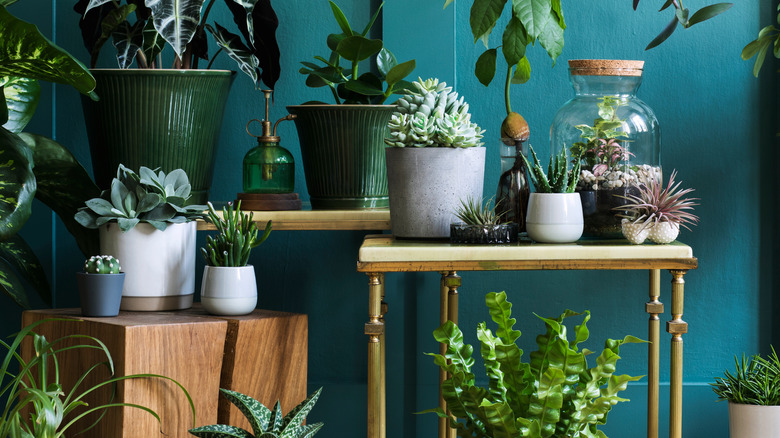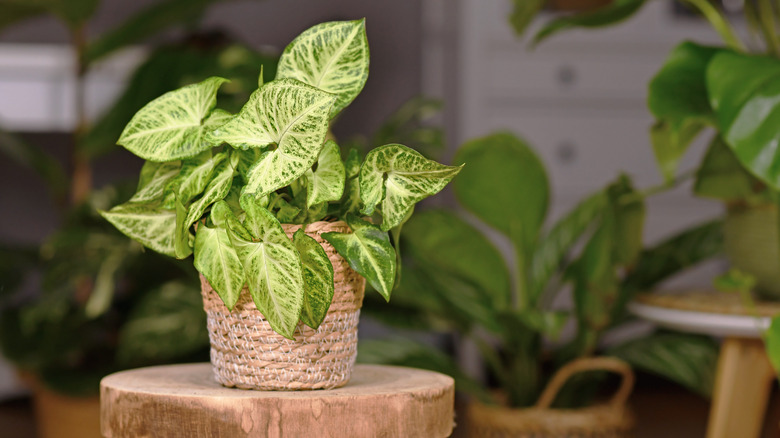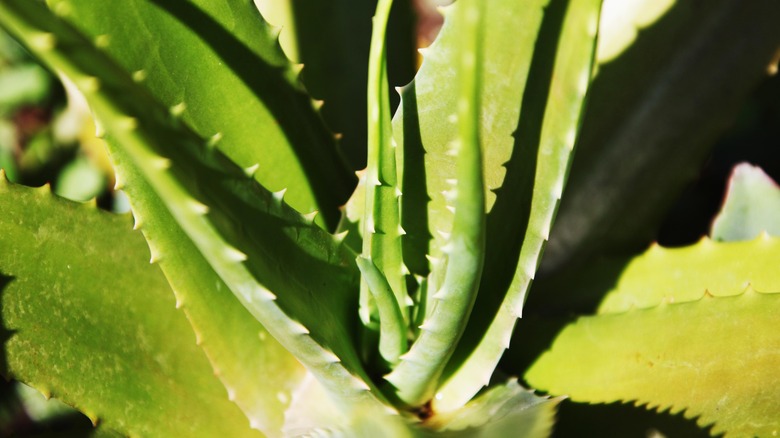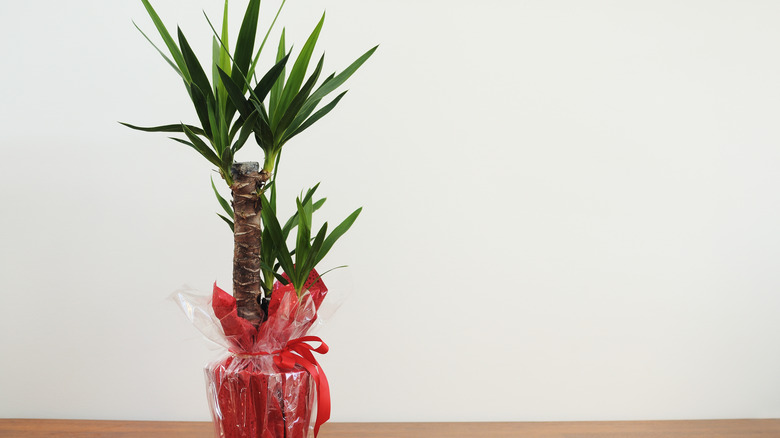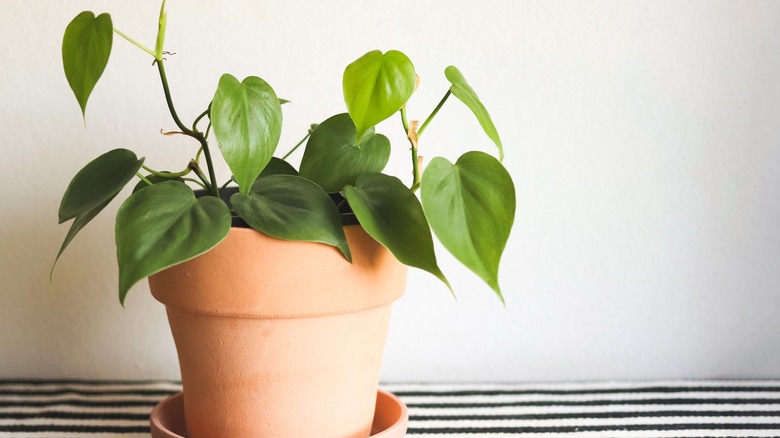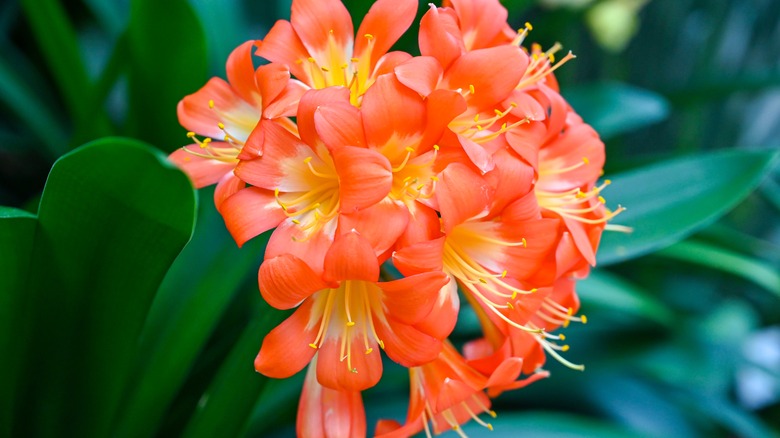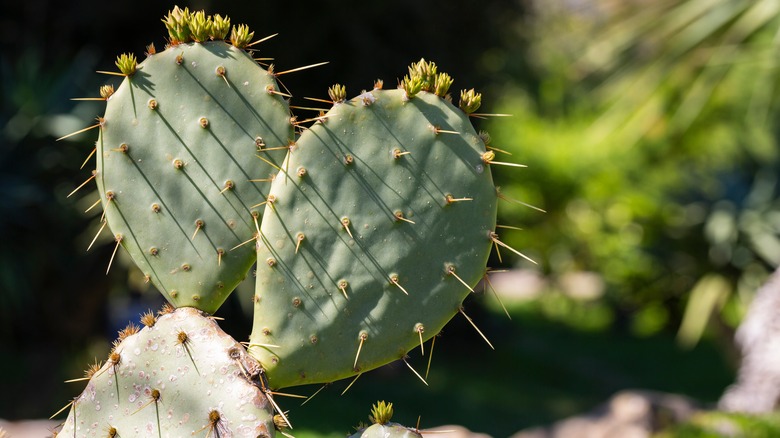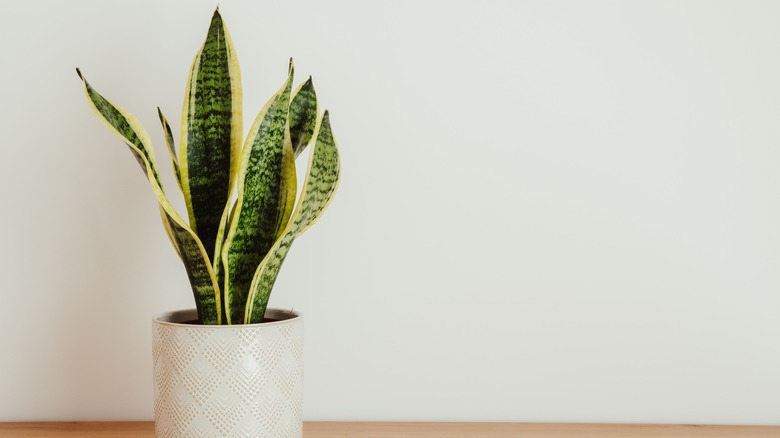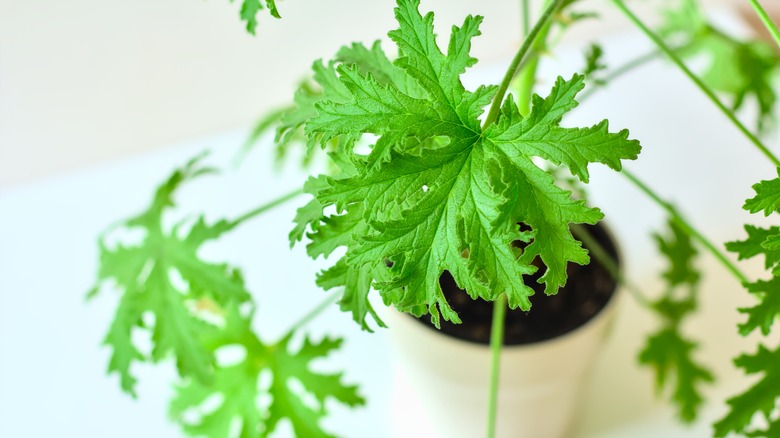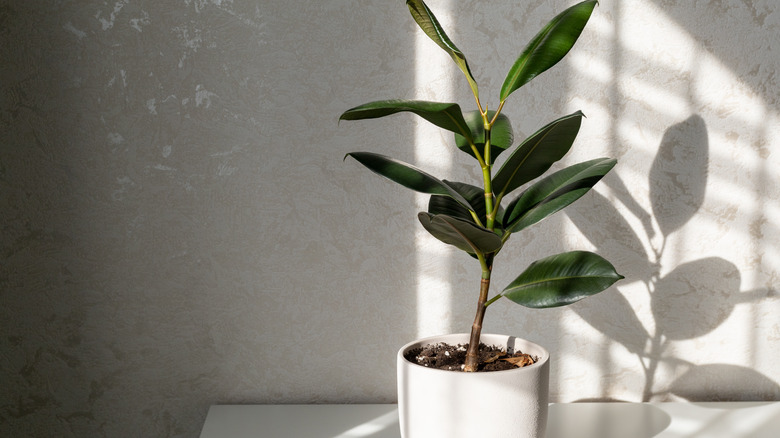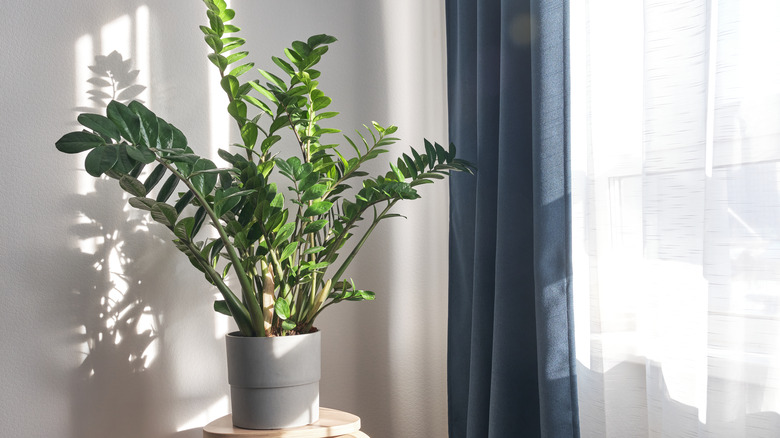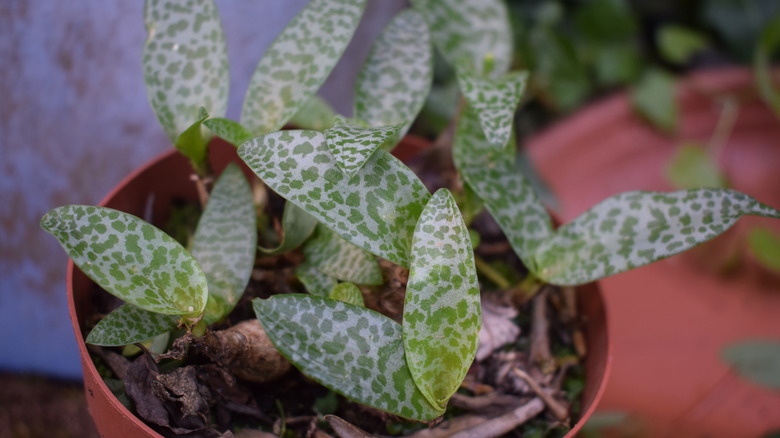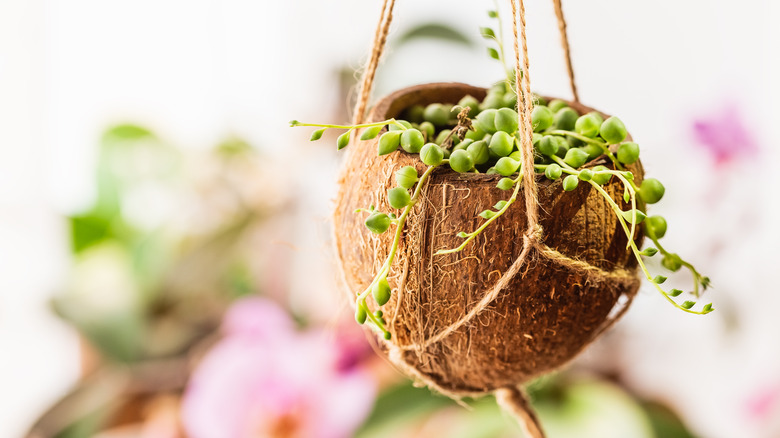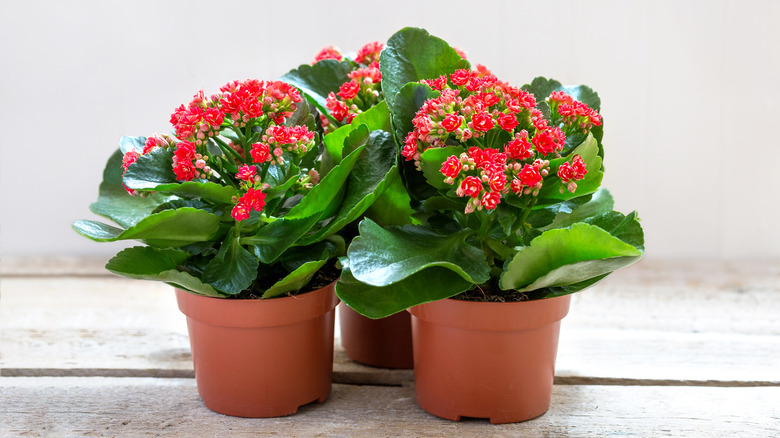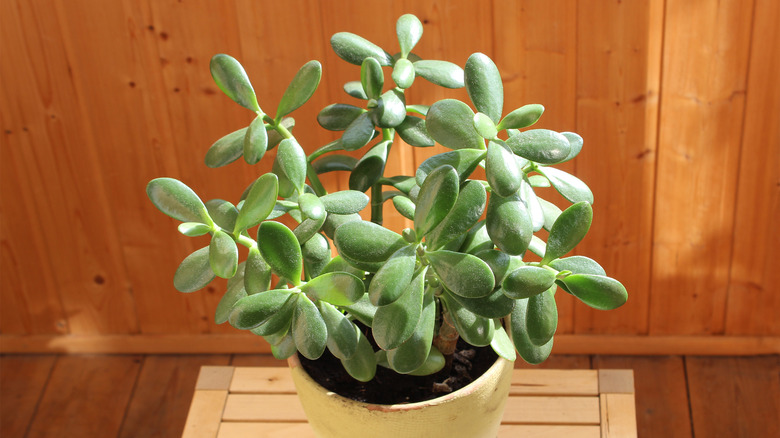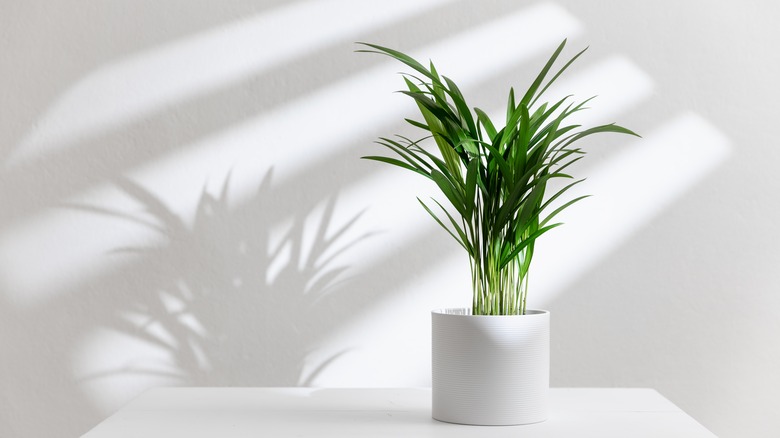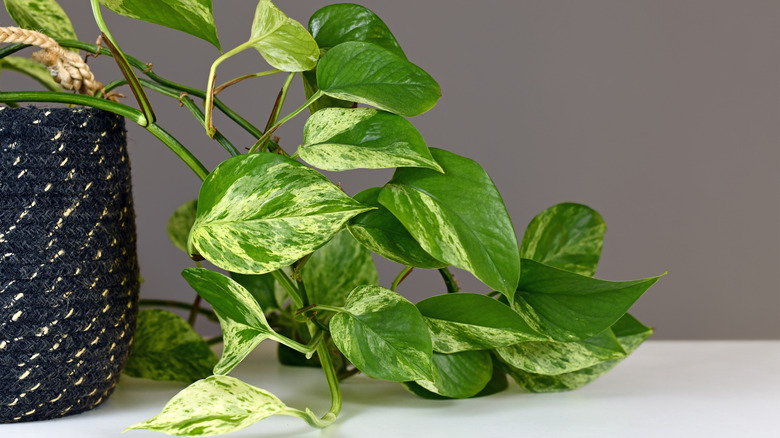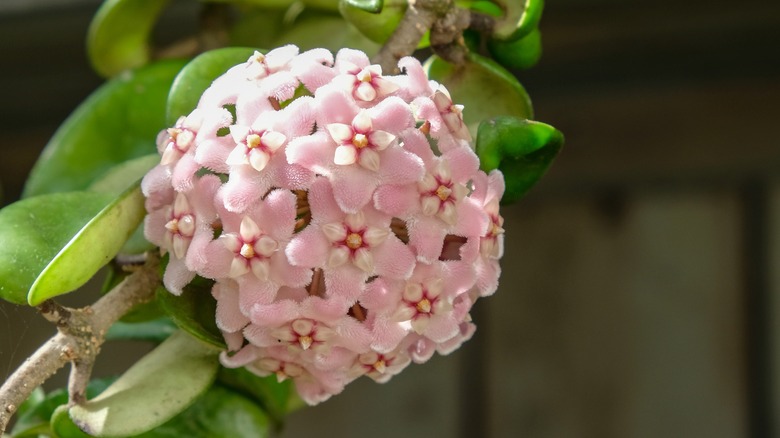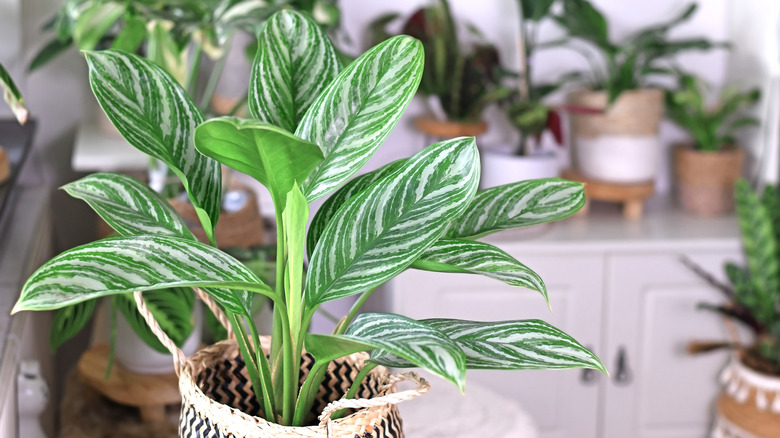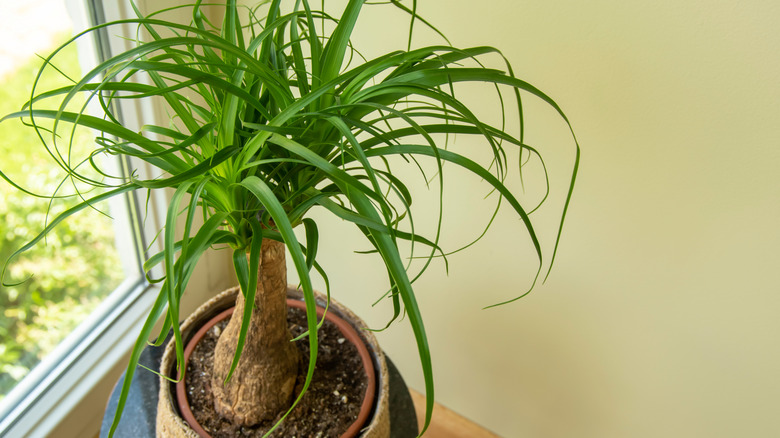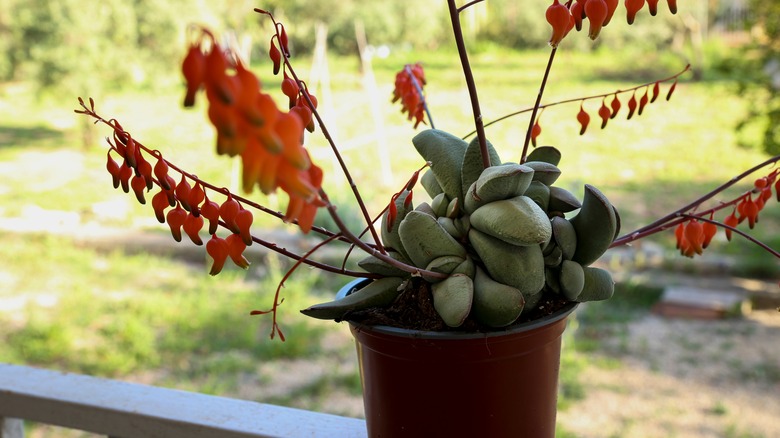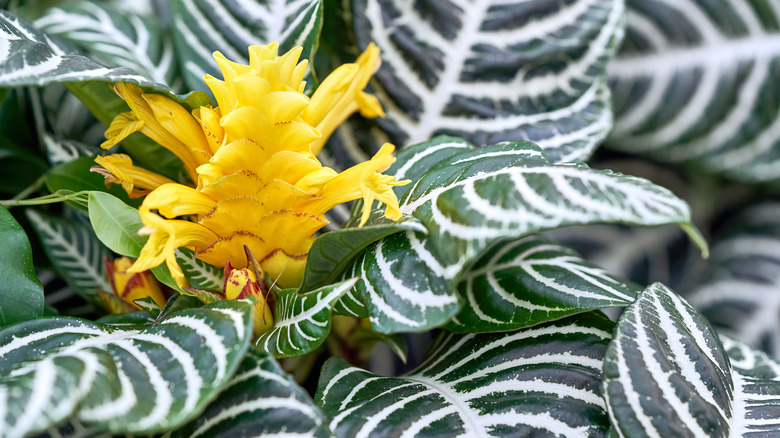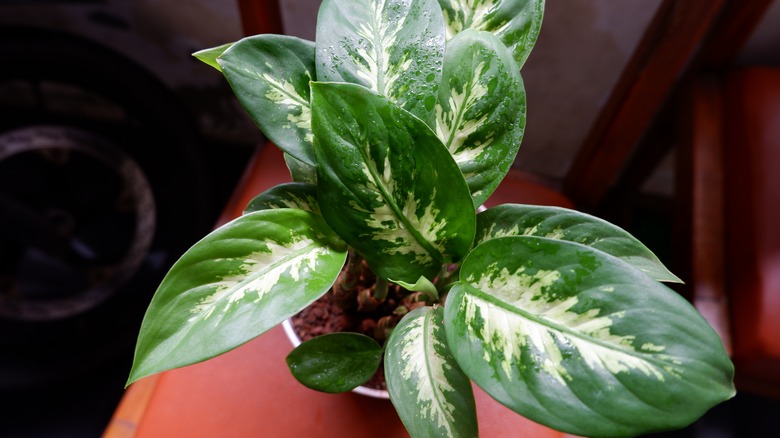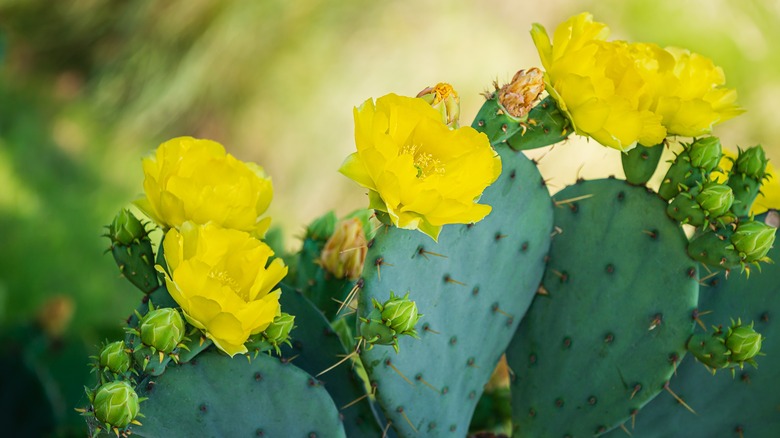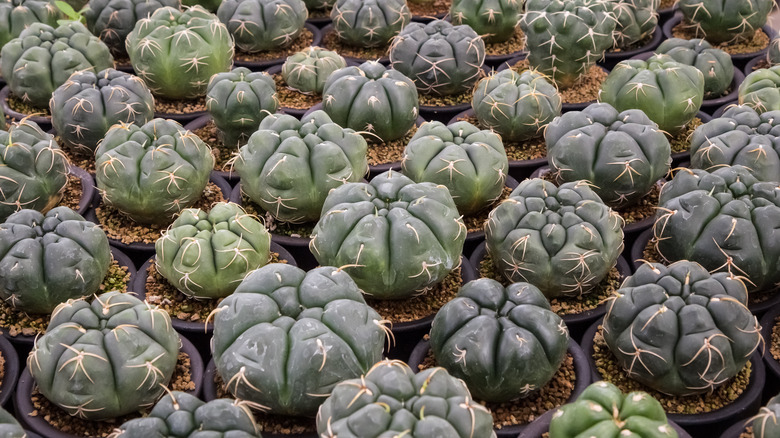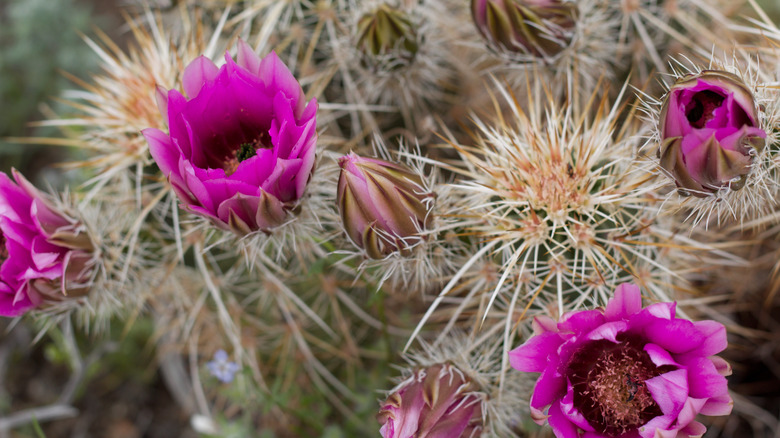25 Houseplants That Thrive In Dry Climates
If you love houseplants but hate giving them near-constant attention, you need to stick to species that enjoy low humidity. When looking for houseplants, novice plant parents often unwittingly search for the most interesting tropical plants that require indirect sunlight and warm indoor temperatures. However, there are more factors to consider if you want to raise a healthy plant inside your home. Humidity is one of them. Many tropical plants native to South America, Southeast Asia, and parts of Africa like the Congo, need constant humidity to survive. This means you have to mist and water them frequently, or even buy a humidifier just for them.
According to Fairfax Gardening, the humidity in your home should be between 30 and 50% to keep mold from developing while keeping it moist enough that the air won't cause bloody noses, dry lips, or sore throats. Some gorgeous and unique plants enjoy this lower level of humidity. Plants from northern or South Africa, northern Mexico, and central Australia can live quite happily in dry indoor air due to the adaptations they have made to live in intensely hot and dry climates. In this collection, we've compiled 25 of the best houseplants to grow in your home without needing to turn it into a wet jungle.
1. Arrowhead vine
The arrowhead vine (Syngonium podophyllum) features triangular leaves and long, trailing stems that can climb walls, trellises, and posts, explains the Royal Horticultural Society. This plant, which grows best in a somewhat sunny location, doesn't need much humidity to survive. Just be sure to water it regularly during the growing season.
Bloom Season: Summer
USDA Growing Zone: 10 to 12
Growing Conditions: Bright indirect light
Soil Type: Well-drained potting mix
Size: Up to 7 feet tall
2. Aloe vera
The aloe plant (Aloe barbadensis) has some of the easiest care requirements. With a well-draining potting mix, a bit of water, and indirect light, it will continue to grow. Like other succulents in this collection, it should not be overwatered. University of Florida recommends never letting your aloe plant sit in water because it could develop root rot or other related diseases.
Bloom Season: Late winter to spring
USDA Growing Zone: 8 to 11
Growing Conditions: Bright indirect light
Soil Type: Well-draining potting mix
Size: Up to 2 feet tall
3. Spineless yucca
Spineless yucca plants (Yucca elephantipes) are showy houseplants that grow quite tall over time. Native to Mexico and Guatemala, the yucca is accustomed to growing in dry conditions. Though this plant is drought-tolerant, you should water yours regularly so the soil doesn't stay dried out for too long, advises Missouri Botanical Garden.
Bloom Season: Spring and summer
USDA Growing Zone: 9 to 10
Growing Conditions: Bright indirect light
Soil Type: Sandy and well-draining potting mix
Size: 15 to 30 feet tall and 15 to 25 feet wide, much smaller grown indoors
4. Heartleaf philodendron
An easy-to-grow heartleaf philodendron (Philodendron hederaceum) can be found in many homes; Missouri Botanical Garden says that it may be the most popular philodendron species sold today. Also native to parts of Mexico and Central America, it needs moderate watering and little maintenance to grow into a gorgeous trailing vine. The heartleaf philodendron is a good choice if you're looking for houseplants that will up your feng shui game.
Bloom Season: Spring and summer
USDA Growing Zone: 10 to 11
Growing Conditions: Bright indirect light
Soil Type: Well-draining potting mix
Size: 10 to 20 feet long
5. Clivia
Clivia (Clivia spp.) is a flowering houseplant known for its winter blooms, shade-loving inclination, and diverse-looking species and cultivars. University of Wisconsin-Madison suggests setting up this plant alongside other winter-blooming plants such as azaleas and amaryllis. Its flowers are bright and showy, and they bloom on a continual basis.
Bloom Season: Winter or early spring
USDA Growing Zone: 9 to 10
Growing Conditions: Medium to low indirect light
Soil Type: Humus-rich and well-draining potting mix
Size: 2 to 3 feet tall and wide
6. Bunny ear cactus
Bunny ear cacti (Opuntia microdasys) get their name from their strange green-yellow pads that branch apart to appear like bunny ears. University of Arizona describes the cactus as a flowering and low-branching succulent. It needs very well-draining soil, little water, and plenty of direct sunlight to survive.
Bloom Season: Spring and summer
USDA Growing Zone: 7 to 11
Growing Conditions: Bright direct sunlight
Soil Type: Cactus and succulent potting mix
Size: 2 to 3 feet tall and 4 to 6 feet wide
7. Snake plant
Snake plants (Dracaena trifasciata) are among the most recognizable houseplants. Their long, variegated, and upright leaves are both attractive and unique among succulent species. In addition to their beautiful shape, snake plants are also very easy to grow and they can thrive in extremely dry conditions, as per Penn State Extension.
Bloom Season: Spring
USDA Growing Zone: 9 to 11
Growing Conditions: Bright or medium indirect light
Soil Type: Well-draining potting mix
Size: 6 inches to 3 feet tall, depending on the variety
8. Scented geranium
Scented geranium (Pelargonium graveolens) can be a great houseplant option if you're looking for something with fragrance and stunning blooms. This flowering perennial is recognized for its ability to grow in dry and warm Mediterranean climates, says the Royal Horticultural Society. However, it will be killed by frost, high humidity, and overwatering if you aren't careful.
Bloom Season: Late spring and summer
USDA Growing Zone: 9 to 12
Growing Conditions: Bright direct light
Soil Type: Well-draining potting mix
Size: 1 to 2 feet tall and wide
9. Rubber tree
Rubber trees (Ficus elastica) are a welcome addition to most homes. They can be a challenge to establish as a houseplant, but when they begin to mature, they will grow happily for years to come. Clemson Cooperative Extension warns that this tree may grow too large if it isn't pruned regularly. They often grow up to 10 feet tall, even when they are strictly kept indoors.
Bloom Season: Spring and summer
USDA Growing Zone: 10 to 11
Growing Conditions: Bright, medium to low indirect light
Soil Type: Well-drained potting mix
Size: 6 to 10 feet tall
10. ZZ plant
The ZZ plant (Zamioculcas zamiifolia) is tolerant of drought, low light levels, and neglect, notes University of Florida. Most notably, it barely needs to be watered; about twice per month should be enough. ZZ plants are appreciated for these qualities when grown as houseplants because they can grow with very little maintenance or change to your current indoor environment.
Bloom Season: Rarely flowers
USDA Growing Zone: 9 to 10
Growing Conditions: Medium to low indirect light
Soil Type: Well-drained potting mix
Size: 16 to 32 inches tall
11. Silver squill
Silver squill (Ledebouria socialis) is a bulbous perennial native to South Africa. Grown in an indoor environment, it shows off spotted, evergreen foliage with purple stalks of flowers in the spring. San Marcos Growers states that the silver squill plant can act as a good houseplant in most regions where it becomes too cold to grow outside.
Bloom Season: Spring
USDA Growing Zone: 10 to 11
Growing Conditions: Bright to medium indirect light
Soil Type: Cactus and succulent potting mix
Size: Less than 1 foot tall and wide
12. String of pearls
As long as your home is warm enough, the string of pearls plant (Senecio rowleyanus) can survive without much water or sunlight. This trailing plant's spherical leaves help to minimize water loss from evaporation which is a common trait among succulents native to South Africa. It allows them to thrive in arid environments, explains University of Wisconsin-Madison.
Bloom Season: Summer
USDA Growing Zone: 9 to 11
Growing Conditions: Bright indirect light
Soil Type: Well-draining
Size: 1 to 3 feet long
13. Calandiva
Calandiva (Kalanchoe blossfeldiana), also known as a flowering kalanchoe plant, is a succulent species that is frequently grown indoors during the colder months because of its winter blooms. The calandiva plant prefers warm temperatures and somewhat dry soil. The most important thing to avoid when growing this beautiful species is overwatering, warns Clemson Cooperative Extension.
Bloom Season: Early spring
USDA Growing Zone: 10 to 12
Growing Conditions: Bright indirect light
Soil Type: Well-draining potting mix
Size: 8 inches to 1 foot tall
14. Jade plant
The jade plant (Crassula argentea) is another succulent that stores water in its leaves which allows it to go long periods without attention. It can grow up to 4 feet tall if it's given the space to grow, however, University of Florida mentions that most home gardeners choose to let it become root bound in order to keep it small.
Bloom Season: Spring
USDA Growing Zone: 10 to 11
Growing Conditions: Bright, medium, or low indirect light
Soil Type: Well-draining potting mix
Size: 2 to 4 feet tall and 1 to 3 feet wide
15. Bamboo palm
The bamboo palm (Dypsis lutescens), which can be referred to as the areca, butterfly, cane, or yellow palm, is a tropical plant native to Madagascar, per North Carolina State Extension. Bamboo palms are known for their extremely ornamental fan-like foliage. In adulthood, this houseplant may become as tall as 10 feet, but it can be kept smaller in the right sized container.
Bloom Season: Summer
USDA Growing Zone: 10 to 11
Growing Conditions: Bright indirect light
Soil Type: Well-draining potting mix
Size: Up to 10 feet tall
16. Devil's ivy
Devil's ivy plants (Epipremnum aureum), more commonly known as pothos, are among the most popular and easiest houseplants to grow. They are adaptable to a range of climate conditions including dry indoor air. If you're having trouble keeping your leafy, tropical houseplants alive, try a species like this which will thrive under neglect and drought, recommends The Sill.
Bloom Season: Does not flower
USDA Growing Zone: 10 to 12
Growing Conditions: Low light to bright light
Soil Type: Well-draining potting mix
Size: 6 to 10 feet long when grown indoors
17. Honey plant
Honey plants (Hoya carnosa) are a species of trailing hoya that can be trained to grow along walls, trellises, and posts. They enjoy bright light, but do not need direct sun to survive. In the spring and summer, the honey plant produces clusters of small, star-shaped flowers that are quite beautiful, notes North Carolina State Extension.
Bloom Season: Spring and summer
USDA Growing Zone: 10 to 12
Growing Conditions: Bright direct and indirect light
Soil Type: Well-drained, organic potting mix
Size: 2 to 4 feet long
18. Chinese evergreen
Chinese evergreen plants (Aglaonema commutatum) are herbaceous perennials that grow well in areas that are dry and shady. Despite this, their soil should be kept evenly moist for the best growth. Missouri Botanical Garden mentions that this showy, warm-weather plant can be identified by its flowers made up of a white spadix with a green spathe, but one of its best qualities is its green and patterned foliage.
Bloom Season: Spring and summer
USDA Growing Zone: 10 to 12
Growing Conditions: Low or medium light
Soil Type: Humus-rich and well-draining
Size: 12 to 18 inches tall
19. Ponytail palm
The ponytail palm (Beaucarnea recurvata) is an ornamental broadleaf evergreen that prefers dry indoor heated air, which causes most other plants to suffer. It needs little water and very low humidity to live. During its growing season, the soil beneath the ponytail palm should be allowed to dry out before it gets watered again, advises North Carolina State Extension.
Bloom Season: Spring and summer
USDA Growing Zone: 10 to 11
Growing Conditions: Bright direct light
Soil Type: Well-draining potting mix
Size: Less than 4 feet tall when container-grown
20. Ox tongue
Ox tongue (Gasteria glomerata) is a unique succulent named for its leaves which are shaped like thick ox tongues stacked on top of one another. The foliage is typically bright green, but some cultivars have a gray hue to them. Mountain Crest Gardens indicates that the ox tongue succulent is relatively hard to kill, making it a houseplant that even beginners can grow.
Bloom Season: Spring
USDA Growing Zone: 10 to 11
Growing Conditions: Medium to low indirect light
Soil Type: Well-draining potting mix
Size: 3 to 5 inches
21. Zebra plant
The zebra plant (Aphelandra squarrosa) shares a common name with other plants such as the Haworthia zebra plant, but it looks much different. As described by Missouri Botanical Garden, it's a broadleaf evergreen displaying large green foliage with thick white veins. In the wild, the zebra plant grows up to 6 feet tall, but, as a houseplant, it stays considerably smaller.
Bloom Season: Summer to fall
USDA Growing Zone: 11 to 12
Growing Conditions: Medium to low indirect light
Soil Type: Peaty and well-draining potting mix
Size: 4 to 6 feet tall and wide
22. Dumbcane plant
The dumbcane plant (Dieffenbachia amoena) is a tall-growing houseplant with decorative foliage. This dieffenbachia species is popular due to its easy-to-grow nature and beautiful growth habit, however, it's also known to be toxic if consumed, according to Miracle-Gro. If you choose to grow it, be sure to keep it away from children and pets.
Bloom Season: Rarely flowers
USDA Growing Zone: 11 to 12
Growing Conditions: Bright indirect light
Soil Type: Lightweight potting mix
Size: Up to 6 feet tall
23. Prickly pear cactus
The eastern prickly pear cactus (Opuntia humifusa) is characterized by wide and flat blue-green pads and large yellow flowers that bloom in the summer months. As explained by Prairie Moon Nursery, this low-growing cactus is a lover of dry, sunny conditions, so you should be sure not to overwater it and keep it in the brightest area in your home.
Bloom Season: Summer
USDA Growing Zone: 4 to 9
Growing Conditions: Bright indirect light
Soil Type: Sandy and well-draining potting mix
Size: 6 inches tall
24. Chin cactus
Chin cacti (Gymnocalycium pflanzii) are a spherical species of cacti that feature irregular mounds that produce long, thin spines all over the body. Mountain Crest Gardens classifies the plant as a bumpy member of the Cactaceae family that can survive in a range of conditions except for frost. It is easily grown in a well-draining cactus and succulent potting mix and bright indirect light.
Bloom Season: Spring to summer
USDA Growing Zone: 10 to 11
Growing Conditions: Bright indirect light
Soil Type: Well-draining potting mix
Size: 3 inches tall and 6 inches wide
25. Hedgehog cactus
Like many other cacti species, the hedgehog cactus (Echinocereus engelmannii) can grow in very dry environments. Indoors, this cactus only needs well-draining soil and bright, direct sunlight. According to the Lady Bird Johnson Wildflower Center, with proper care, the hedgehog cactus will produce bright to pale pink flowers during the spring season. These blooms typically last several days before giving way to red fruit.
Bloom Season: Spring
USDA Growing Zone: 5 to 9
Growing Conditions: Bright direct light
Soil Type: Well-draining potting soil
Size: Up to 10 inches tall
